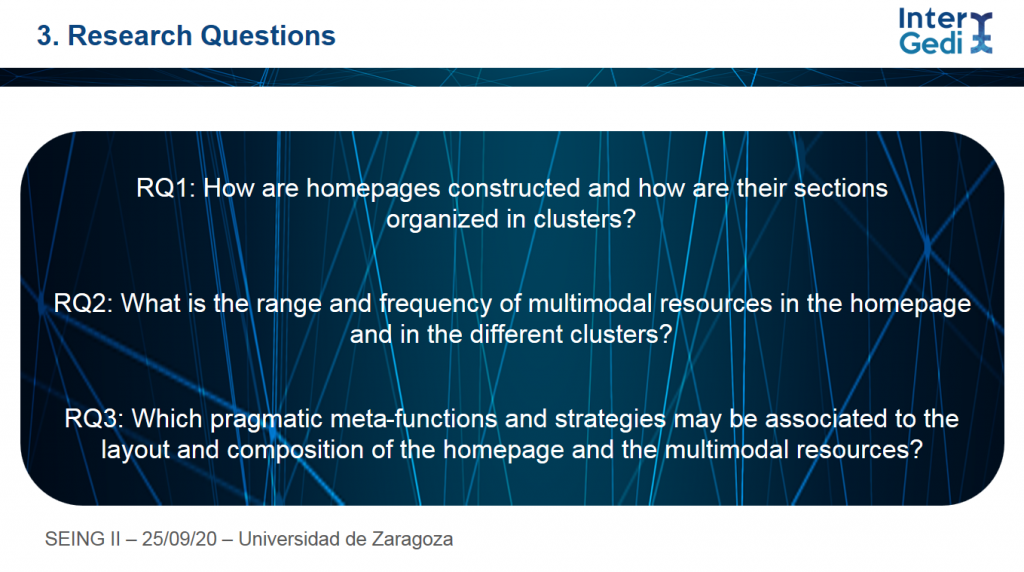SEING II 2020: PhD colleague Daniel Pascual shares his latest progress in his PhD thesis
The SEING II Seminar was a very enriching event organised in the Department of English Studies at the Universidad of Zaragoza that gathered predoctoral students from a lot of national universities . This year the conference was developed in online format (inevitably) and was titled “English Studies Across Genres, Media and Modes”.

As a PhD candidate at the organising university, our InterGedi research member, Daniel Pascual, contributed to the event by presenting a combined pragmatic and multimodal analysis of the homepages in research project websites. By grouping visual and verbal elements into clusters and looking into the pragmatic macro- and micro-strategies conveyed through them, he showed how research groups organise the content and layout in the homepages of their projects. Three were the research questions he tried to answer:
Preliminary results of this section in his PhD thesis were shared and fruitful Q&As followed his talk. Here is the full abstract of his paper at SEING III:
A pragmatic approach to the verbal and the visual in research project homepages
Abstract:
Texts and genres in digital environments purposefully combine verbal and visual affordances in the crafting of their structure. Concerning homepages, the window entrance to a website and the first layer of meaning and effect for the readership, layout seems a meaningful notion to pragmatically display one’s specific intent through verbal and visual resources. This qualitative study about international research project homepages seeks to analyse the layout and the different verbal and visual components that make them up from a pragmatic perspective. Accordingly, a corpus of 10 homepages managed by H2020-funded research projects were selected. Layout, referring to the code of spatial composition (Kress and van Leeuwen 2006), served as an analytical tool to delve into the structure of the homepage and the distribution of multimodal texts. These were grouped into clusters to understand their saliency and function, as well as to analyse the pragmatic functions and effects displayed according to the homepage composition. Results first indicate the position and organization of the different website sections in the homepages as scrolled down with the aim to identify the relevance and space given to the section and find recurrent patterns. Second, the range and the frequency of modal resources (e.g. logos, images, videos, hyperlinks) are discussed, as employed in the layout of the homepage and as inserted in the different clusters. Then, a pragmatic analysis distinguishing three scopes or meta-functions (communicative, promotional and interactional) is proposed to match the layout and composition of the homepage and the pragmatic intent behind. This study may contribute to identifying research groups’ communicative purposes and practices when showcasing their projects digitally by observing the pragmatic strategies conveyed in the mixing of the verbal and visual. This can help understand how these multimodal resources of meaning-making promote project-related information and researchers’ portrayal of their collective identity
References
Kress, G. and van Leeuwen, T. 2006. Reading Images. The Grammar of Visual Design. London: Routledge.
